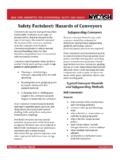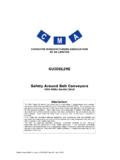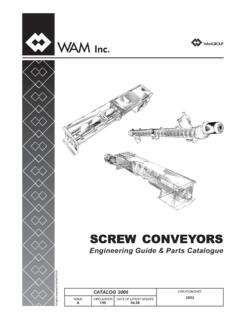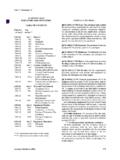Transcription of CONVEYORS Design fundamentals for drive …
1 22 Australian Bulk Handling Review: March/April 2009 CONVEYORS1. KeywordsConveyor, conveyor drive , multiple drive , drive control system, variable voltage variable frequency control, variable speed drive , variable frequency drive , second-ary resistance control (SRC), squirrel cage induction motor (SCIM), wound rotor induction motor (WRIM), fluid coupling, electronic soft starter, direct on line start, breakaway torque, acceleration torque, conveyor resistance forces, conveyor ef-ficiency, conveyor drive SynopsisThe combination of a number of fac-tors can result in conveyor drives being undersized or operating in an unsuitable manner. Some of these factors include:The trend to reduce drive sizes by reducing friction coefficientsThe trend towards using squirrel cage induction motors under variable voltage variable frequency controls combined without considering the drive characteristicsNot analysing the operation and in- teraction of fluid couplings with the motor torque not allowing for break-away resistances, or not allowing for some components of break-away resistancesNot allowing for load sharing in mul- tiple drive systemsNot allowing for surge (transient but sustained variations in throughput)
2 Procured drive and conveyor compo- nents being different to the Design components resulting in different resist-ances and different drive characteristicsCorrect conveyor drive Design can be achieved by allowing for realistic load cases and ensuring that the drive system selected can provide adequate torque to overcome these resistances. This paper discusses concepts for establishing conveyor resistances and the features of various drive technologies and de-rating factors which should be IntroductionItems which have contributed to under-size conveyor drives being designed, or drives being designed which have not operated correctly are discussed in this paper. Various trends which have led to these outcomes are discussed and method-ologies which should be employed during Design to ensure fit for purpose outcomes are also discussed.
3 The broad areas discussed by this paper include:Determination of conveyor resistances Assessment of de-rating factors Features of various conveyor drive technologiesDesign suggestions to minimise energy losses in conveyor systemsIn addition to incorrect drive sizing, drives can fail due to control system is-sues and these are also discussed briefly as a drive control system philosophyA conveyor that is operating and con-tinues to operate safely with an alarm condition allowing an overload to be corrected will cause less problems than a conveyor that is stopped as soon as the alarm is raised. A back up trip should occur if the alarm condition is not resolved quickly. Two stage alarm/trip settings give excellent control and examples are:If the gearbox oil temperature reaches a preset safe limit, it will not fail im-mediately and therefore the conveyor should not be immediately stopped.
4 A ten degree Celsius additional rise should trip the electric motor that reaches peak current for a few seconds will not burn out, however if this persists and the motor thermal rating is reached a trip is needed. Higher end motor protec-tion relays (MPR) can accommodate a detailed motor thermal limit curve to allow for many over-current use of two stage belt wander detec- tion/indication is strongly set up can cause spurious trip outs that mask the real reason for a con-veyor not breaking away:When using delay fill fluid coupling drives, motion at full load conditions may take many seconds. Ensure that the zero speed trip timers allows for this. Ensure that the motor does not trip out on an arbitrary electrical limit that does not harm the motor (an 85% maximum current trip is often set on many mine drives).
5 Proper setup of the MPR can eliminate this type of nuisance that other instruments (oil pressure, flow, temperature, zero speed, vibration etc.) are bypassed for the starting duration unless deemed the set up of the VSD is as the actual voltage drop under starting as this is drive dependant, with direct on line starting being the conveyor resistancesThe basic conveyor resistance forces are calculated by using the international standard, ISO 5048(1) in most parts of the world, with CEMA(2) ( conveyor Equipment Manufacturers Association) still finding preference in North America. Although both these methods provide a realistic assessment of resistance forces for most conveyor applications, other resistance forces must be considered, particularly during starting.
6 These resist-ances include:Allowance for static friction (or break- away friction), sometimes referred to as stiction .Allowance for full or blocked chutes. Allowance for inertial resistance of the belt and its components during Break-away frictionOften neglected, this resistance force can be significant, especially when analysing relatively long, flat (horizontal) CONVEYORS where the resistance due to material lift is negligible and the frictional resistances summate to make the main resistance. It is common industry practice to multiply the artificial coefficient of friction (ISO Design fundamentals for drive systems on conveyorsBy Luke Meakin* and Peter Saxby, Hatch23 Australian Bulk Handling Review: March/April 2009 CONVEYORS5048) by a factor of to to calculate breakaway Full chutesTwo types of philosophy apply to chute Design :Traditional closed chute designs Open profile velocity chutes (some- times referred to as hood and spoon chutes or soft loading chutes)Many chutes are enclosed to control dust and also to act as storage containers in the event of an uncontrolled stop due to power failure, or an emergency stop.
7 In the case where this type of chute be-comes full, or becomes blocked, it acts in a similar fashion to a belt feeder hopper and exerts significant resistances on the conveyor . A conveyor which has multiple feed chutes discharging on to it may have a sizable proportion of its starting resist-ance comprised of resistance forces due to full chutes. The profile velocity chutes which have become popular for handling relatively free flowing materials such as coal, generally are of an open Design . As a general rule, to prevent spillage during an emergency stop, conveyor stopping times are controlled by us-ing brakes or flywheels to ensure one conveyor does not feed onto the other in these circumstances. For this type of chute a case may exist for not allowing for full chutes resulting from an emer-gency stop.
8 Experience indicates that most chutes will block at some time for reasons be-yond normal controlled conditions. When this happens it is preferable that the con-veyor fed by the chute is able to self start. In general, the full chute resistance forces can be conservatively calculated in a simple fashion by using the vertical pressure due to hydrostatic head of the material in the chute above the profile plate and multiplying it by the coeffi-cient of internal shear of the material. This shear stress is then multiplied by the area of the shear plane behind the profile plate to obtain an estimate of the initial (break-away) pull out force required. The time taken to empty the chute during acceleration should be calculated and taken into account when preparing the torque versus time graph for conveyor starting conditions.
9 Once the material is flowing in the chutes some cushioning of the load onto the belt occurs in a similar way to that which is observed with belt feeders(3). An approximation of the resistances due to full chutes during acceleration (as opposed to break-away) can be deter-mined by simply halving the resistances calculated for the break-away Inertial resistance during accelerationIn order to accelerate the belt and other live conveyor components (idlers, pulleys etc) to full running speed, there is an iner-tial resistance which must be overcome. Although this resistance force can be low in modern designs which use electronic soft starters, secondary resistance and VVVF controls, it still should be calculated and included in the specifications used to size the con-veyor drive and controller.
10 Most modern computer programmes determine the belt tensions for both run-ning and acceleration scenarios. There-fore this resistance can be quite simply determined by subtracting the effective tension (Te = T1 T2) for the accelera-tion case from the effective tension for the running case. Alternatively, it can be manually calculated with relative Torque versus time graphA number of phases and component re-sistances are considered when analysing predicted motor torques during start-up. During break-away conditions the resistances due to blocked chute condi-tions, the resistances due to static friction and the inertial resistances are added to the base running resistances. This analy-sis is conservative as it does not take the elasticity of the belt into account.




